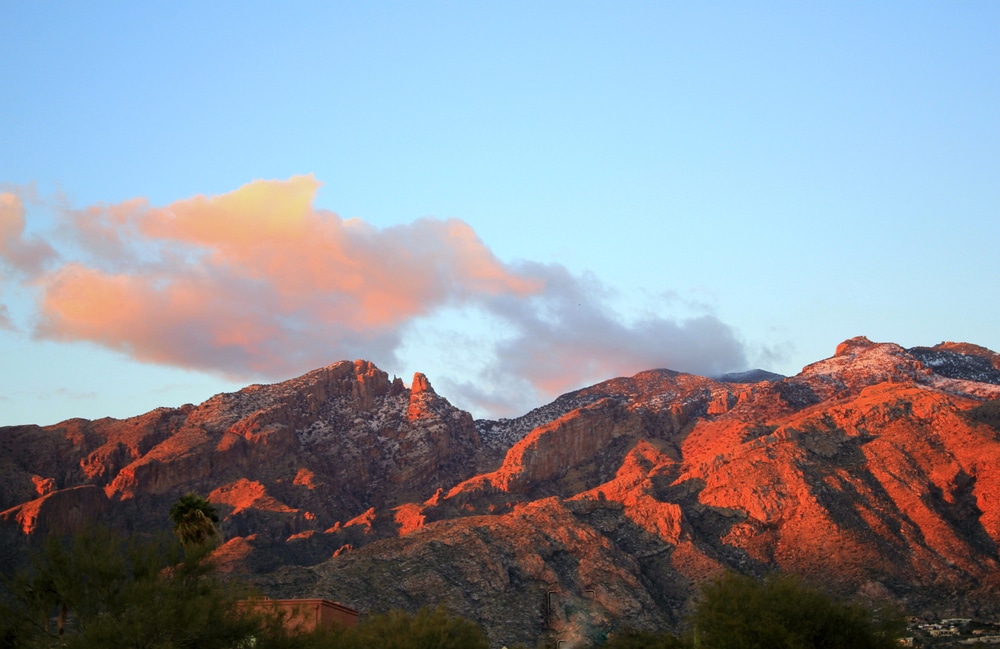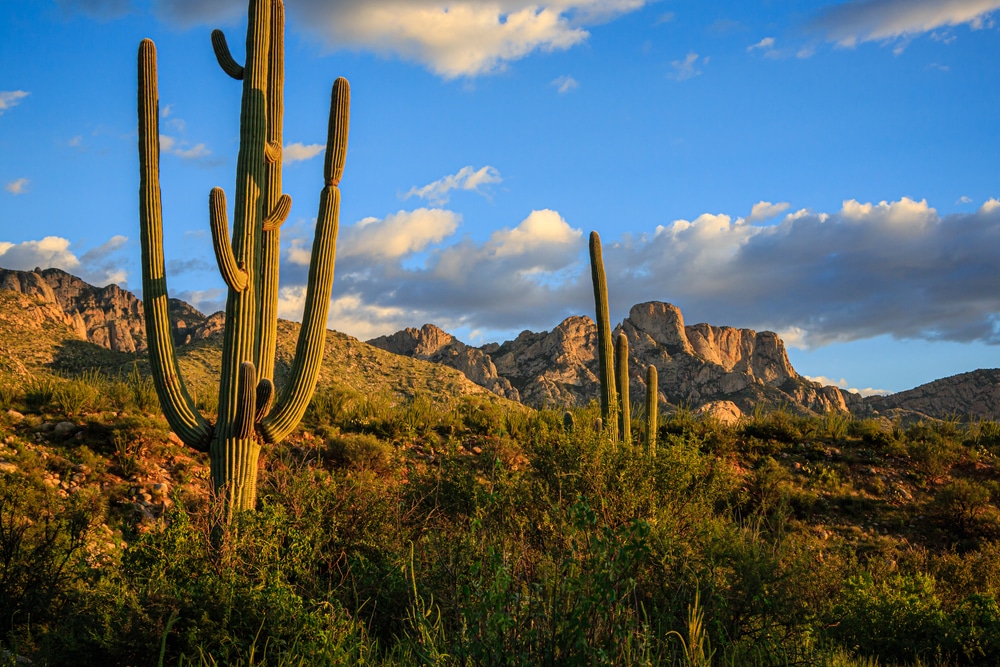Nestled at the base of the majestic Santa Catalina Mountains just north of Tucson, Catalina State Park offers visitors a stunning desert sanctuary spanning 5,500 acres of pristine Sonoran Desert landscape. This natural treasure showcases nearly 5,000 saguaro cacti standing sentinel across rolling foothills, rugged canyons, and seasonal streams that create a vibrant ecosystem for diverse desert flora and fauna. Established on May 25, 1983, after a complex process that began in the early 1970s when public opposition arose against a proposed housing development on the historical Rancho Romero land, the park now offers a perfect balance between wilderness adventure and accessibility.
The park’s establishment wasn’t without challenges. Representative Charles King requested a feasibility study that led to legislation passed in 1974. With the help of University of Arizona students who developed a master plan, and through a series of land exchanges, leases, and appropriations, Governor Bruce Babbitt finally dedicated the park in 1983. Today, Catalina State Park is managed by Arizona State Parks and Trails under a Special Use Permit from the USDA Forest Service.

Just minutes from metropolitan Tucson in Oro Valley, the park serves as a gateway to the Santa Catalina Mountains while offering numerous recreational opportunities. With its extensive trail network, camping facilities, and educational programs, Catalina State Park has become one of Arizona’s most beloved state parks, representing the rich natural heritage of the Sonoran Desert while providing a critical protected habitat at the urban-wilderness interface.


Catalina State Park maintains an extensive network of equestrian-friendly trails and dedicated horse facilities. The Bridle Path offers a relatively flat route ideal for horseback riding, while more adventurous riders can access the backcountry via the 50-Year and Sutherland Trails. The park provides an equestrian staging area with ample trailer parking, water troughs, and mounting ramps for convenient access.

Catalina State Park offers over 5,500 acres of pristine Sonoran Desert landscape with eight major hiking trails ranging from easy nature walks to challenging mountain treks. The Romero Canyon Trail leads hikers to refreshing seasonal pools, while the Sutherland Trail connects to the extensive Mount Lemmon trail system. The Canyon Loop Trail provides a moderate 2.3-mile route showcasing desert vegetation and mountain views accessible to most fitness levels.

The dramatic backdrop of the Santa Catalina Mountains against the Sonoran Desert landscape creates spectacular photographic opportunities. The changing light throughout the day transforms familiar scenes, with sunrise and sunset being particularly magical. Seasonal wildflower blooms and summer monsoon storms add dramatic elements to landscape photography, while the diverse wildlife and plant life offer endless macro photography possibilities.

The park is recognized as an Important Bird Area with over 170 documented species. The riparian corridors along Sutherland Wash and Romero Canyon create unique habitat for desert and mountain birds, attracting both year-round residents and seasonal migrants. Cactus wrens, Gambel’s quail, roadrunners, and several hummingbird species are commonly spotted, while lucky observers might glimpse rarer species like elegant trogons during migration periods.

The park’s campground features 120 developed sites accommodating both tents and RVs with amenities including water, electricity, picnic tables, and fire rings. Modern restrooms with hot showers enhance the camping experience. The campsites are thoughtfully arranged to maximize privacy while offering stunning views of the Santa Catalina Mountains. The campground provides a perfect base for multi-day exploration of the park’s natural features.

Catalina State Park maintains several designated picnic areas equipped with tables, grills, and shade ramadas. These areas offer spectacular mountain views and convenient access to drinking water and restroom facilities. The picnic grounds are situated among native desert vegetation, creating pleasant natural settings for outdoor meals and family gatherings throughout the year.

| Category | Details |
|---|---|
| Location | Oro Valley, Arizona, USA (at the base of the Santa Catalina Mountains) |
| Area | 5,500 acres (22.3 km²) |
| Elevation | 2,700 to 3,000 feet (820-914 m) |
| Established | 1983 |
| Landscape | Sonoran Desert foothills transitioning to mountain terrain |
| Management | Arizona State Parks in partnership with U.S. Forest Service |
| Facilities | 120 campsites with water and electric hookups, picnic areas, equestrian center |
| Trails | Over 10 miles (16 km) of hiking, biking, and equestrian trails |
| Popular Trails | Romero Canyon Trail, Sutherland Trail, Canyon Loop Trail, Birding Trail |
| Wildlife | Deer, javelina, coyotes, bobcats, over 150 species of birds |
| Plant Life | Saguaro cactus, ocotillo, cholla, paloverde, mesquite, wildflowers |
| Water Features | Seasonal streams and pools in Romero Canyon, Sutherland Wash |
| Archeological Sites | More than 5,000 years of human habitation evidenced by Hohokam ruins |
| Notable Mountain | Mount Lemmon visible from park (9,157 feet/2,791 m) |
| Annual Events | Guided hikes, star parties, outdoor concerts |
| Best Time to Visit | Spring wildflower season, fall and winter for milder temperatures |
| Special Features | Excellent birding location, spectacular wildflower displays in spring |
| Distance from Tucson | Approximately 15 miles (24 km) north |
| Special Designation | Part of the 5,500-acre Catalina State Park/Santa Catalina Natural Area |
Catalina State Park covers over 5,000 acres of diverse desert landscapes, from dense saguaro cactus forests to riparian areas along seasonal creeks, providing a perfect blend of dry, arid terrain and surprising pockets of lush greenery. The park offers panoramic views of the surrounding mountain ranges, especially the towering peaks of the Santa Catalina Mountains that rise dramatically from the desert floor.
The elevation within the park ranges from approximately 2,800 feet at the lower desert areas to around 3,000 feet in the foothills, creating varied microclimates that support a rich diversity of plant communities. This transitional zone between the lower Sonoran Desert and the mountain ecosystems creates a biological richness that’s easily accessible to visitors.
The park’s most notable geological features include the low granite cliffs and boulders along Sutherland Wash, which cuts through the park creating a natural corridor for wildlife and a seasonal watercourse that, when flowing, transforms the landscape with shallow pools that persist into early summer. During monsoon season (typically July through September), these typically dry washes can quickly transform into flowing streams, bringing life-giving water to the desert ecosystem.
Geologically, the Catalina Mountains feature a central core of granite of Laramide origin, altered by metamorphism to gneiss along its western side. The park itself is situated near the base of the fore range anticline, which drains into Cañon de Oro to the west. The park land rests on sedimentary Miocene deposits of sandstone, limestone, mudstone, and conglomerates that are approximately 25 million years old.
The park’s unique location at the mountain base creates a watershed that channels precious water through the desert landscape. Though streams are seasonal, they play a crucial role in the park’s ecosystem, supporting riparian vegetation and providing water sources for wildlife, especially during the hot, dry months. When flowing, these streams create desert oases that attract a variety of animals and birds, making them excellent spots for wildlife viewing.
The botanical diversity of Catalina State Park represents the richness of the Sonoran Desert ecosystem, with the iconic saguaro cactus serving as the most recognizable symbol. The park is a haven for desert plants and wildlife, with an impressive diversity of cacti, shrubs, and trees adapted to the challenging desert conditions.
Among the most prominent plant species found throughout the park are mesquite, acacia, palo verde, ocotillo, two varieties of yucca (soaptree and Schott’s), agave chrysantha, nolina, sotol, and a variety of cacti including saguaro, echinocereus fasciculatus, mammillaria grahamii, ferocactus wislizenii, opuntia phaeacantha, and six species of cholla. Along the washes where water is more abundant, visitors can find desert willow, Arizona sycamore, Arizona ash, and native walnut trees.
The park is renowned for its exceptional birdwatching opportunities, hosting more than 150 species of birds throughout the year. This impressive avian diversity makes it a premier destination for birders of all experience levels. The varied habitats within the park—from desert uplands to riparian corridors—support different bird communities, and the park offers guided bird walks to help visitors identify and appreciate the feathered residents and migrants.
Mammals that roam the park include mule deer, coyotes, javelinas, bobcats, and jackrabbits. Most desert animals are nocturnal, making early morning and late evening the best times for wildlife viewing. Other wildlife includes ground squirrels, packrats, numerous lizards, and snakes. While rare, mountain lions, bighorn sheep, and black bears have occasionally been observed in the park.
The park’s ecosystem changes throughout the seasons. Winter and spring bring cooler temperatures and, if rainfall has been sufficient, spectacular wildflower displays that carpet the desert in vibrant colors. Summer’s intense heat forces many animals into inactivity during daylight hours, though the monsoon rains bring renewed activity and growth. Fall brings milder temperatures and increased wildlife activity, making it an excellent time for nature observation.
Catalina State Park offers an abundance of recreational opportunities for visitors of all ages and interests, with hiking being the most popular activity. The park provides miles of equestrian, birding, hiking, and biking trails which wind through the park and into the adjacent Coronado National Forest at elevations near 3,000 feet.
There are eight trails varying in length and difficulty. All trails are multi-use except Romero Ruin. Leashed dogs are welcome on all trails, and free trail guides are available at the Visitor Center. Here are some of the most notable trails:
Horseback riding is a popular way to experience the park’s beauty. Catalina State Park offers horseback riding activities through its concessionaire, Rancho De Los Cerros. The equestrian center provides a staging area for trail riders with trailer parking. Sixteen pens are available first-come, first-served at no charge. All park trails are open to horses except the Romero Ruin Trail.
Photography enthusiasts will find endless opportunities to capture the stunning landscapes, especially during the golden hours of sunrise and sunset when the mountains glow with warm light. Wildlife photography is also rewarding, particularly along the riparian areas and during spring wildflower season.
Stargazing is exceptional at Catalina State Park due to its distance from major light pollution. The park occasionally hosts star parties and astronomy events where visitors can learn about the night sky and observe celestial objects through telescopes.
While there are no lakes or permanent water bodies for fishing or boating within the park itself, the seasonal streams provide beautiful scenery and habitat for wildlife. After heavy rains, the normally dry washes can fill with water, creating temporary oases in the desert landscape.
Catalina State Park offers excellent camping facilities with 120 campsites that provide electric and water hookups. Each campsite has a picnic table and BBQ grill, and the roads and parking slips are paved. The campgrounds feature modern flush restrooms with hot, clean showers, and RV dump stations are available in the park.
There is no limit on the length of RVs at this park, but reservations are limited to 14 consecutive nights. Campgrounds are open all year, and reservations are recommended, especially during the peak season from October through April when visitors from colder climates flock to Arizona’s mild winter weather.
Campgrounds A and B offer beautiful electric campsites at $50 per night. There is a $3.60 non-refundable reservation fee for each reserved site and a $15 per night fee for second vehicles at a campsite.
Two vehicles are allowed per campsite, and all vehicles must be parked within campsite boundaries and on the proper surface. Only one RV/camper is permitted per campsite, and all vehicles are restricted to paved roads.
Wood burning is never allowed in the campground; fires can use charcoal, firelogs (such as Duraflame), or propane. Quiet hours are from 10:00 pm to 7:00 am, and generator hours are from 8:00 am to 8:00 pm.
For those who prefer not to camp, the park is a day-use destination with Tucson and Oro Valley offering numerous accommodation options just minutes away. From luxury resorts to budget-friendly motels, visitors can easily find lodging that suits their preferences and budget while still enjoying easy access to the park.
What sets Catalina State Park apart is its remarkable proximity to Tucson. Just a short drive away, campers can easily access the vibrant city to explore its cultural attractions, dine at diverse restaurants, and shop for supplies. This accessibility makes it an excellent choice for those who want to enjoy the serenity of the outdoors without sacrificing the convenience of urban amenities.
For large groups, the park offers group camping areas that can be reserved for day or overnight use. These areas are perfect for family reunions, scout troops, or other organizations looking to enjoy the outdoors together.
Catalina State Park is open daily, with standard hours from 5 a.m. to 10 p.m. The entrance station typically operates from 8 a.m. to 5 p.m. daily. During holidays, hours may vary; on Thanksgiving and Christmas Eve, the park is open from 8:00 a.m. to 2:00 p.m., while it remains closed on Christmas Day.
Entrance fees as of 2025 are: $10.00 per vehicle with 1 person, $20.00 per vehicle with 2-4 people, and $5.00 for individuals or bicycles. Annual passes are available for frequent visitors and provide cost savings for those who plan to visit multiple Arizona State Parks throughout the year.
The best time to visit Catalina State Park depends on your preferences and tolerance for desert conditions. October through April offers mild temperatures ideal for hiking and outdoor activities, with daytime highs typically ranging from 60°F to 80°F (15°C to 27°C). This is also the busiest time of year, so camping reservations should be made well in advance.
Summer (May through September) brings intense heat, with temperatures routinely exceeding 100°F (38°C), making early morning or evening activities preferable. However, the summer monsoon season (July through September) brings spectacular thunderstorms and temporary water features to the park, along with increased humidity and lush desert growth.
Spring (March-April) is particularly beautiful when wildflowers bloom after winter rains, creating carpets of color across the desert landscape. This is also when many cacti flower, adding splashes of vibrant color to the scenery.
When planning your visit, be aware that roads near campsites may face flash flooding during monsoon season, which could prohibit campers from leaving the park until flooding subsides. The park advises maintaining awareness of surroundings and weather conditions at all times.
Cell phone service is generally available throughout the park, though signal strength may vary in canyon areas. Limited Wi-Fi may be available at the Visitor Center, but connectivity should not be relied upon for critical communications or work needs.
Pets are welcome in Catalina State Park but must be kept on leashes no longer than six feet at all times. Pet owners must clean up after their animals, and pets should never be left unattended, especially in hot weather. Dogs are NOT allowed in the surrounding Pusch Ridge Wilderness (e.g., Romero Pools).
Most facilities, including restrooms and shower facilities, are accessible. The Bridle Trail is the flattest trail in the park and may be suitable for some visitors with mobility limitations. The Visitor Center and main picnic areas are also designed to be accessible.
The Visitor Center is located at the park entrance and is open approximately 8 a.m. to 5 p.m. daily. Entrance and camping permits are issued here, and information is available about the park and the local vicinity. The Visitor Center features a small gift shop selling postcards, maps, books, field guides, drinking water, snacks, sunscreen, hats, and tee-shirts.
Educational exhibits showcasing the natural wonders of southern Arizona are located in the Visitor Center, helping visitors learn more about the area’s ecology, geology, and cultural history. Rangers are available to answer questions and provide additional information about the displays.
Park facilities include the campground, picnic tables, grills, trails, an equestrian center, a group use area for day or overnight use (available by reservation), restrooms, showers, and a gift shop.
Flush restrooms are available in the visitor center, picnic area, group areas, and campgrounds. Waterless restrooms are available at the trailhead and equestrian center. All restroom facilities are handicap accessible.
Two RV dump stations are available in the park, free for registered campers but with a $15 per vehicle dumping fee for those not registered in the campground. Hot showers in the restroom buildings at campgrounds and group areas are for use by registered campers only.
The park offers several picnic areas with tables, grills, and ramadas that provide shade from the intense desert sun. These areas are perfect for family gatherings, with nearby restroom facilities and access to hiking trails.
While there are no boat ramps or marinas within the park due to the lack of permanent water bodies, the Equestrian Center provides facilities for horse owners, including trailer parking and horse pens.
The Main Trailhead is located 1.5 miles north from the Ranger Station at the end of the main entry road and offers amenities including restrooms, water spigots, picnic tables, trash cans, recycling, a stage, a vending machine, an information kiosk, bicycle parking rack, and a seasonal gift shop.
There are no food or supplies within the park itself, with the nearest services about 1 mile away. Visitors should come prepared with water, snacks, and any supplies they may need for their activities, though basic items can be purchased at the gift shop.
Catalina State Park is ideally situated to serve as a base for exploring the many attractions in and around Tucson. Oracle State Park is a 4,000-acre wildlife refuge in the northern foothills of the Catalina Mountains, offering day-use picnic areas and over 15 miles of trails. It’s also a designated International Dark Sky Park.
Other nearby natural areas include:
Cultural attractions in the area include the Arizona-Sonora Desert Museum, a world-renowned zoo, natural history museum, and botanical garden that showcases the Sonoran Desert’s biodiversity. The Pima Air and Space Museum is the third largest aviation museum in the world, exhibiting more than 300 aircraft and 125,000 artifacts. The Arizona State Museum, the oldest and largest anthropology museum in the Southwest, offers insight into the vibrant and enduring Native cultures of the region.
For those interested in historic sites, nearby options include:
The vibrant city of Tucson offers numerous dining options, from casual eateries to fine dining establishments featuring authentic Southwestern cuisine and international flavors. Shopping opportunities range from local artisans selling handcrafted items to modern malls and shopping centers.
Local businesses cater to outdoor enthusiasts with gear rentals, guided tours, and advice on exploring the region’s natural wonders. Outfitters can provide equipment for hiking, mountain biking, and other outdoor activities, while tour operators offer experiences ranging from bird watching to stargazing.
Catalina State Park faces ongoing conservation challenges, including the threat of invasive plant species. The park regularly organizes volunteer events like “Help eradicate buffelgrass from the park and Save Our Saguaros!” to combat non-native plants that threaten the native ecosystem.
In June 2020, the Bighorn Fire, started by a lightning strike, burned through portions of the Santa Catalina Mountains until late July, affecting some areas of the park and surrounding forest. Post-fire restoration efforts have helped the ecosystem recover, with many plants showing remarkable resilience in the aftermath of this natural disturbance.
Visitor responsibilities include adhering to Leave No Trace principles: stay on designated trails, pack out all trash, respect wildlife by observing from a distance, minimize campfire impacts by using only designated fire rings with approved materials, and be considerate of other visitors.
Park regulations prohibit damaging, defacing, or removing natural features. Vehicles must remain on paved roads, and visitors should never attempt to drive through flooded roads. Proper waste disposal is essential, with gray water discharged only into designated dump facilities.
Educational programs run throughout the year, offering opportunities to learn about the park’s natural and cultural history. These include guided bird walks led by experienced bird guides, Native Plant Society tours along the Canyon Loop trail, reptile exhibits, geology talks, and history programs exploring the park from the 1850s to today.
Volunteer opportunities allow visitors to contribute to the park’s conservation mission. From assisting with trail maintenance to participating in citizen science projects monitoring wildlife and plant populations, volunteers play a crucial role in preserving the park for future generations.
By fostering an appreciation for the unique Sonoran Desert ecosystem and encouraging responsible recreation, Catalina State Park continues to fulfill its mission of conservation while providing meaningful outdoor experiences for visitors. Through ongoing stewardship efforts, this desert oasis will continue to thrive as a testimony to Arizona’s natural heritage and the importance of protecting wild spaces at the urban interface.
Swimming is possible at Romero Pools when water is present, typically after winter rains or during monsoon season. However, water levels are unpredictable and the hike to reach the pools is moderately strenuous.
Wood fires and ground fires are prohibited in the campground. Campers may use charcoal, firelogs (such as Duraflame), or propane for cooking and warmth.
Dogs are welcome on all trails within Catalina State Park but must be kept on leashes no longer than six feet. Dogs are NOT allowed in the surrounding Pusch Ridge Wilderness, including the Romero Pools area beyond the park boundary.
The Nature Trail (1 mile) and Romero Ruins Interpretive Trail (3/4 mile) are excellent options for beginners, offering relatively flat terrain and interpretive signage about the park’s natural and cultural history.
Cell service is generally available throughout the park, though signal strength may vary in canyon areas and more remote sections of the trails.